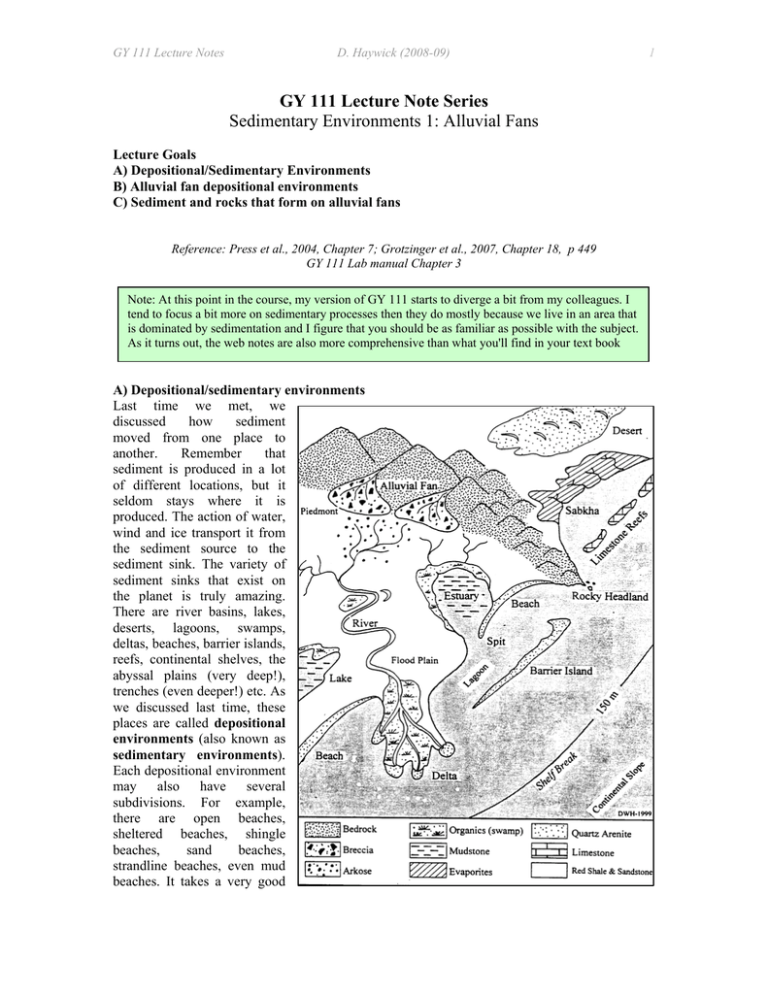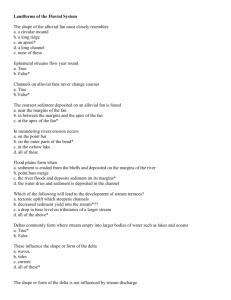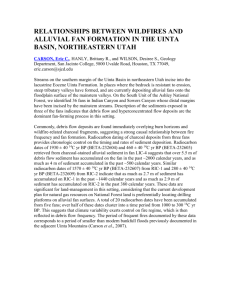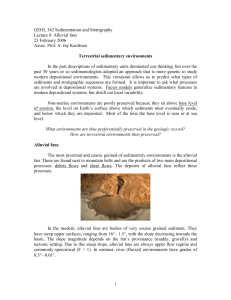GY 111 Lecture Note Series Sedimentary Environments 1: Alluvial Fans
advertisement

GY 111 Lecture Notes D. Haywick (2008-09) GY 111 Lecture Note Series Sedimentary Environments 1: Alluvial Fans Lecture Goals A) Depositional/Sedimentary Environments B) Alluvial fan depositional environments C) Sediment and rocks that form on alluvial fans Reference: Press et al., 2004, Chapter 7; Grotzinger et al., 2007, Chapter 18, p 449 GY 111 Lab manual Chapter 3 Note: At this point in the course, my version of GY 111 starts to diverge a bit from my colleagues. I tend to focus a bit more on sedimentary processes then they do mostly because we live in an area that is dominated by sedimentation and I figure that you should be as familiar as possible with the subject. As it turns out, the web notes are also more comprehensive than what you'll find in your text book A) Depositional/sedimentary environments Last time we met, we discussed how sediment moved from one place to another. Remember that sediment is produced in a lot of different locations, but it seldom stays where it is produced. The action of water, wind and ice transport it from the sediment source to the sediment sink. The variety of sediment sinks that exist on the planet is truly amazing. There are river basins, lakes, deserts, lagoons, swamps, deltas, beaches, barrier islands, reefs, continental shelves, the abyssal plains (very deep!), trenches (even deeper!) etc. As we discussed last time, these places are called depositional environments (also known as sedimentary environments). Each depositional environment may also have several subdivisions. For example, there are open beaches, sheltered beaches, shingle beaches, sand beaches, strandline beaches, even mud beaches. It takes a very good 1 GY 111 Lecture Notes D. Haywick (2008-09) 2 geologist (actually it takes a very good sedimentologist) to be able to recognize these sedimentary environments in the rock record. And it is necessary that they can for some of these environments are major reservoirs of petroleum and natural gas. In order to find oil and gas, you need to know where to look and this requires cunning, skill and good guessing. B) Alluvial Fans Alluvial fans are very large conical deposits of sediment that occur adjacent to mountains. Alluvial fans can be huge. Some extend for over 100 km away from the mountains. In Nevada and California, I have seen separate fans that coalesce into exceptionally wide “aprons” of sediment that stretch as far as the eye can see. If it sounds like I am impressed by these depositional environments it’s because I am. They contain a diverse suite of sediment and sedimentary rocks that are easy to relate to. Alluvial fans (see photo to right) are best developed in dry (arid) climates like California and Nevada where there is a sudden transition from a steep slope to a shallow slope. The climate may be arid, but rain still occurs sometimes (in fact it comes down very heavily when it falls at all). The water spills down the mountains into the valleys between them very rapidly. The faster the current, the bigger the particles of sediment that can be moved (This is GY 111 Lecture Notes D. Haywick (2008-09) 3 a recurring theme in sedimentology and you are advised to remember it when we talk about other sedimentary environments). Mountain streams can transport boulders metres across, but when they get to the flat plains surrounding the mountains (the alluvial plain), the currents suddenly slow down and most of the largest and heaviest material is dropped. This usually starts at the base of the mountains and as time goes on, the alluvial fans get higher and wider at the base. Most alluvial fans have a concave up profile and a relatively steep slope as far as geology is concerned (2 to 10°). I was once driving up one in Nevada and really didn’t realize for better than 45 minutes that I was actually going up hill. When I stopped to see how high I got, I was amazed to see how far I could see. In that dry desert air, I could see at least 200 km. Las Vegas was still visible on the distant horizon despite my efforts to put as many miles between me and it. If you ever want to see waste at its worst, visit that city. They might be located in a desert, but they use water like it was the Gulf Coast. C) Sediment and rocks on alluvial fans One of the reasons I like alluvial fans is that the sediment they are composed of was derived from the rocks they are sitting on. To put it more succinctly, the sediment that makes up alluvial fans was not transported very far at all so abrasion has not yet rounded the sand and gravel-sized particles and chemical weathering has not had time to destroy all of the unstable grains. We say that the sediment making up alluvial fans is immature because it is angular and contains a lot of feldspar. In contrast, beach sediment is mature as it consists almost entirely of stable minerals like quartz. Since most mountains on continents are composed of granite and alluvial fans are on continents, the sediment that comprises alluvial fans contains a lot of orthoclase (Please don’t tell me that you have forgotten that granite contains quartz, orthoclase and biotite/hornblende). Another neat thing about alluvial fans is that you can predict the grain size of the sediment that will be deposited on them. The coarsest stuff (gravel) is deposited right at the base of the mountain where the slope change is the greatest at the fan head. The gravel passes into sand in the middle of the fan and then into silt and clay (“mud”) in the tail of the fan. Indeed, the mud of the fan tail passes laterally into mud on the alluvial plain (we will discuss this environment in our next lecture). So as you go from the fan head to the fan tail, you get a progressive fining sequence (see cartoon atop next page). Well I guess all that is left to discuss is the sedimentary rocks that are form on alluvial fans. Before we do this, just remember that all sedimentary environments are initially sites of sedimentation (i.e., deposition of unconsolidated sediment). The sediment is converted into sedimentary rock later (sometimes much later) through the processes of lithification and GY 111 Lecture Notes D. Haywick (2008-09) 4 cementation. Alluvial fans are sites of deposition of immature angular gravel, sandstone and mud. When these sediments get cemented or lithified, they turn into, respectively breccia, arkose and shale. The mud will be deposited in an oxygenated terrestrial environments so any iron minerals in the mud will turn it red. The resulting rock is a red shale. I have spoken several times about how cleaver sedimentologists are when it comes to looking for oil and gas and resolving the history of the Earth. It is now time to “come clean” and let you all in on a secret. We’re not all that smart. We are just able to imagine the past based upon our understanding of the present. Let me show you what I mean using what we have discussed in class today as an example. We now know that breccia, arkose sandstone and red shale are all rock types that can be found in an alluvial fan. We know this because two of the three rocks are immature as we would expect in an alluvial fan environment and the other is indicative of terrestrial (oxidizing) environments. So if we find a sequence of rocks that contains breccia, arkose and red shale, there is a very good chance that those rocks were deposited in an alluvial fan environment (duh). If the rocks are 500 million years old, it means that 500 million years ago, there was an alluvial fan at that location. Moreover, 500 million years ago, there was an alluvial fan adjacent to a mountain at that location. The mountain eroded long ago, but the evidence of its existence is still preserved in the sedimentary rocks. The rock record is a record of past events. Like Sherlock Holmes, sedimentologists try to uncover evidence that will allow us to unravel that history. This is why I love geology and in particular, why I am a sedimentology. I get paid to be like Sherlock Holmes in my thinking and no one ever shoots at me!1 In GY 112, we will talk in more detail about the history of our planet, but I’d like to introduce you to one idea now. We have discussed the importance of red shales in alluvial fan environments, but in some alluvial fan sequences, the shales are not red. Some (usually more that 2 billion years in age) are green in colour (Note: the breccias and arkose sandstones are the same). The green colour indicates anaerobic environments (refer to Lab Lecture 3). The fact that green shales occur in alluvial fan sequences more than 2 billion years of age suggests that there was 1 Actually this is not correct. I have been shot at several time while in the “field”(this is how we refer geological field work) in Australia, New Zealand and Alabama. So far, I have yet to be hit. In my case it was because people thought I was trespassing or trying to steel their “stash” (don’t ask). In Sherlock Holmes’ case, it was because he was being targeted by bad boys. GY 111 Lecture Notes D. Haywick (2008-09) 5 little oxygen in our atmosphere more than 2 billion years in the past. It is the sedimentary record that allows geologists to model the past atmosphere2. Important terms/concepts from today’s lecture (Google any terms that you are not familiar with) Depositional (sedimentary) environments Alluvial fans Alluvial plains Immature mature fan head fan tail breccia arkose (arkosic sandstone) red shale fining sequence unconsolidated sediment 2 Geologists now believe that the Earth’s atmosphere did not become oxygenated until about 1.8 billion years in the past. Prior to that, there was no free oxygen in our air (we would not be able to breathe).







